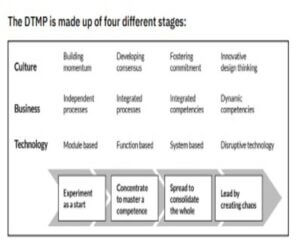Tag: digital transformation
Written by contributing writer, David Galea, Director of Digital Leadership, Centigo
Yes, running fast is key to gaining a competitive advantage in business, but do not be too impatient. Learn to crawl before you walk and learn to walk before you run.
Digital transformation is not a flick of a switch. It involves a major culture change. If your organisation has previously been guilty of creating a paper trail responsible for killing half of the Amazon rainforest, you cannot suddenly cast a magic spell that automates workflows, sparing the lives of a few trees at the eleventh hour. What you can do is take one step at a time along what I call the digital transformation maturity pathway (DTMP). I have developed this framework to support leaders to pace their transformation effort across a cycle that their organisation can handle without creating major disruptions in its day-to-day operations.
The DTMP is made up of four different stages:

Stage one – experiment as a start
This stage of the pathway is appropriate for leaders who are yet to embark on their organisation’s digital journey. The aim is to choose one or two minor projects as pilots to build momentum by generating results from low-hanging fruit. Changing the mindset of all stakeholders is more important at this stage than the results themselves, so the focus is to build a transformation mindset and an organisation-wide acceptance for the need to embark on a digital journey. To build this mindset, ensure that the pilot projects you choose are primed for success and can be completed in cycles of twelve weeks. Develop a plan to raise awareness of digitalisation across the organisation and use these pilot outcomes to instil legitimacy.
Stage two – concentrate to master a competence
This stage of the DTMP is appropriate for organisation leaders who have accepted the need to digitalise their operations, but their business model, people and technology elements are still largely based on manual systems. At this stage, you will need to focus on identifying a competence, not a process, which is critical to your business strategy to become a core priority for digitalisation. A competence consists of a set of skills and/or capabilities your organisation has that adds value to your customer. Competences are developed and defined by a series of interrelated underlying processes.
Once you have earmarked the core competence, identify the underlying processes and resources it is made up of. Then develop a digital roadmap built around enhancing or transforming the processes you’ve identified as making up the core competence.
Stage three – spread to consolidate the whole
This stage of the pathway is appropriate for enterprises that have successfully mastered one competence but have other core competences in need of development to generate a competitive advantage. Your key task at this stage is to prioritise the other competences to be considered for digital transformation. Define linkages across multiple competences and identify how you could create synergies. Develop a digital roadmap that brings together a united vision for exploiting technology to maximise the mix of core competences making up your organisation’s competitive advantage.
Stage four – lead by creating chaos
This stage of the pathway is appropriate for organisations that have leveraged the potential of technology to generate a competitive advantage, but want to become leaders by disrupting their industry. To reach this phase, you will need to re-evaluate your organisation’s business model by focusing on your innovative capability to move to uncharted territory.
Question and review your industry and explore ways in which you can use emerging technologies to redefine your source of competitive advantage. Then develop a digital roadmap that brings together a united vision for repositioning your organisation, based on an alternative source of competitive advantage founded on the development of new competences.
In practice, few organisations have the privilege of reaching this stage as most are still struggling to master a competence or spread to consolidate the whole. Netflix is one of the rare exceptions. This company has succeeded in reshaping the entertainment industry and has brought cable companies to their knees.
Netflix traces its origins to 1997 where it started off as one of the first portals to offer online DVD rentals delivered by mail to its customers. A decade later, following significant improvements in internet speeds, Netflix pioneered its on-demand streaming service, spelling the end of the video rental business. The company went further to lead the way into the development of original programming, putting in place powerful algorithms to analyse user data and repurpose its content to fit customers’ specific requirements and preferences.
Netflix did not stop there. It took the initiative in producing its own content, signing up multi-million- dollar contracts with iconic Hollywood actors such as Adam Sandler, Dwayne Johnson, Sandra Bullock and Ryan Reynolds to name a few. It is no wonder that in 2021 alone, more than 27% of American households were planning to cancel their satellite or cable connections in favour of Netflix.
About the author:
David Galea is a digital transformation expert, Director of Digital Leadership at Centigo and author of Digital Made Simple. Throughout more than 20 years of experience in the consulting industry in Europe, the UK, and the Middle East, he has extensive experience in successfully implementing digital transformation programs in organisations ranging from ambitious and visionary micro enterprises launching new emerging technologies in the market right through to the largest corporations forming part of the Fortune 500 list. He has helped various entrepreneurs in shaping their business models based on DLT, IoT, Bluetooth, AI, ML, and Cloud technologies (amongst others) to launch innovations in the marketplace. David’s new book, Digital Made Simple is all about how to successfully implement digital strategy in any workplace.







